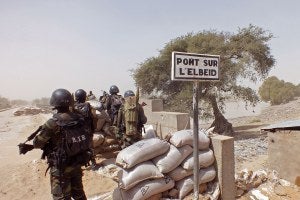Cameroon: Which War Are We Fighting?

US security assistance meant for counterterrorism efforts is also implicated in the government’s war against Anglophone separatists.
Cameroon is a country of 29 million straddling West and Central Africa, rich in natural resources but weak in state capacity and with a GDP of only around $45 billion as of 2021.1 The country’s most severe internal conflicts lie along the porous border with northeastern Nigeria, where it fights Boko Haram insurgents and an Islamic State-affiliated splinter group that emerged in 2016.2 Cameroon has joined Chad, Niger, Nigeria, and others to fight these insurgent groups since 2014. US forces have been by Cameroon’s side, boosting Cameroonian forces in an effort to prevent terrorist groups in the region from growing powerful enough to threaten vital US interests.
However, backing the government in Yaoundé has not addressed the root drivers of insurgency in and near Cameroon, and may in fact be exacerbating them. Cameroon’s military has tortured and killed civilians in its US-assisted campaign against violent extremists. The US affiliation with troops that commit these abuses damages America’s image in Cameroon, and this problem has been compounded since 2017, when Cameroon’s government launched an additional campaign against Anglophone separatists in the country’s North West and South West. This conflict has racked Cameroon even more than the fight against terrorism. Yaoundé’s efforts to forcefully stamp out Anglophone resentment of the central government’s abuses also risks kindling long-term instability in Cameroon, working against US goals in the region.
Since the skills and resources America imparts to the Cameroonian military cannot be easily confined to one conflict or the other, US security assistance is implicated in the government’s war against Anglophone separatists too, raising the question: is this a conflict America wants to help Cameroon fight?
America’s Counterterrorism Focus: Boko Haram
US policy toward Cameroon since 2014 has focused primarily on counterterrorism. In 2009, Nigerian security efforts forced Boko Haram underground, so it began recruiting and setting up logistic hubs in Cameroon’s Far North. Here, the population’s deep poverty and religious, ethnic, and linguistic ties with Nigerians across the border make it fertile ground for Boko Haram’s messaging.
The US approach to combatting Boko Haram involved ongoing training and multilateral military exercises with West African countries since 2007 and supporting troop deployments to Nigeria and neighboring allies. In 2014, these countries formed the Multinational Joint Task Force to coordinate counterterrorism activities. US support also included supplying military equipment.
Cameroon became a prominent partner in this effort starting in 2014, when growing instability in Mali and Libya exacerbated US concerns about the greater Sahel region’s potential as a terrorist safe haven.
US Military Support for Cameroon
As Cameroon became a frontline partner in the fight against Boko Haram and Islamic State-West Africa (IS-WA), it received more US military support, including a train-and-assist program for Cameroon’s Rapid Intervention Brigade (BIR).3 Around 300 US forces deployed to northern Cameroon in 2015 to conduct regional intelligence and surveillance operations.
By that time, the BIR was “an army-within-an-army,” with roughly 5,000 members who were better trained, equipped, and paid than the regular army.4 It reports directly to President Paul Biya, presumably as a form of anti-coup insurance.
In 2014–2015, Boko Haram attacked military bases and communities believed to be cooperating with Cameroon’s government, largely in Cameroon’s Far North region. After suffering defeats in 2015, Boko Haram shifted to an irregular approach using bombs and suicide attacks.5 By 2016, Boko Haram attacks dominated most of Cameroon’s military focus, as the majority of the country’s roughly 12,500 troops were shifted north.6
Although Boko Haram’s strength subsequently fell dramatically, this was far from a simple counterterrorism success story. Instability and violence only continued with the rise of IS-WA, which UN monitors estimated had surpassed Boko Haram’s strength in 2020. In May 2021, IS-WA insurgents killed Boko Haram’s leader, triggering thousands of Boko Haram fighters, family members, and refugees to surrender to Nigerian and Cameroonian authorities.7
The United States would like to take credit for helping rollback Boko Haram by 2020, but the situation overall was no more stable, with IS-WA continuing to harm local civilians and Cameroon’s military committing numerous human rights abuses against civilians and suspected insurgents. An Amnesty International report from 2017 documented that government forces arbitrarily detained, tortured, and extrajudicially killed 101 Cameroonians from March 2013 to March 2017. Most of the victims were military-age men, but numerous victims were women or children.8
Allegations that US-backed forces conducted torture at a base where US forces were present were particularly concerning, since US forces would likely have at least been aware of the torture.9 Torture allegations spurred US Africa Command (AFRICOM) to investigate in 2017.10 But even after 2017, Cameroon’s security services were still reportedly committing human rights abuses. In 2018, Amnesty International released footage that appears to show Cameroonian forces shooting at least a dozen unarmed people.11
Following these allegations, the State Department announced cuts in February 2019 for some $17 million in planned security assistance to Cameroon. Nevertheless, a 2022 investigative report alleges that US special operations coordination with the BIR continued until September 2019.12 By the time of the security assistance cuts, US yearly training expenditures had grown to a post-2013 high of $10.3 million, and two years had passed since AFRICOM launched its internal investigation in response to the Amnesty International report.13 During six years of abuses, from 2013 to 2018, Cameroon received around $219 million in security assistance (including both direct assistance to Cameroon’s forces and US intelligence, surveillance, and reconnaissance operations that assisted Cameroonian forces).14
Allegations that US-backed forces conducted torture at a base where US forces were present were particularly concerning, since US forces would likely have at least been aware of the torture.
Even still, in 2019—the same year Washington slashed military aid to Cameroon in response to human rights abuses—the State Department’s country reports on terrorism stated that Benin, Cameroon, Chad, Niger, and Nigeria (all of the Multinational Joint Task Force countries) lacked the military capacity to clear Boko Haram and IS-WA safe havens in northeast Nigeria and on islands in Lake Chad.15
The long-term risks of continued US support for Cameroonian forces are substantial. Abuses by government forces have likely strengthened recruitment for IS-WA and may trigger the emergence of new insurgent groups in the future. This is all the more possible because Cameroon’s state capacity remains relatively weak; increased US security assistance has changed neither the societal divisions nor the coup-proofed, highly inefficient security services that prevent larger economic growth and more legitimate distribution of opportunity. Not only is the outcome far from US national security goals for the country, but should Cameroon’s leadership change in the future, US support for this abusive regime could be a hard legacy for it to overcome with the Cameroonian public and subsequent governments.
The Anglophone Conflict
The downsides of apparent US complicity in Cameroon’s human rights abuses have increased since 2017 with the onset of the Anglophone conflict. The central government’s growing marginalization of Cameroon’s English-speaking regions spurred protests in 2016. When the Biya government arrested and prosecuted hundreds of civil society activists in a harsh police crackdown, armed separatist groups began attacking government forces, alleged government sympathizers, and schools. The resulting war between separatists and government forces has killed thousands, and both sides have been accused of torture and other human rights abuses.
The BIR, whose abuses in the war against Boko Haram have been well documented, has been and will likely continue to be a central part of Yaoundé’s counterinsurgency strategy against the Anglophone separatists, further implicating US assistance in civilian abuse.
This war also distracts Cameroon’s government from the efforts the United States wants to support, as some analysis has shown that Cameroon’s fight against Anglophone separatists has weakened its fight against Boko Haram and IS-WA.16 Washington may be unable to track whether US-provided equipment or munitions are being diverted to the Anglophone fight.17
Even if the Anglophone rebels are eventually defeated, the war will likely exacerbate the country’s Anglophone-Francophone tensions for a long time to come. Cameroon will remain vulnerable to future internal conflicts—along with instability-fueled terrorist violence—unless Yaoundé can better govern the Anglophone regions. This likely means delegating more authority to regional authorities (the trend under Biya has been centralizing authority instead), but US security assistance does not make this outcome any more likely.18
Continuing security assistance to Yaoundé fails to address key drivers of conflict and violence, and further implicates Washington in human rights abuses. This ultimately widens the gulf between US values and behavior.
- 1
“GDP (current US$)—Cameroon,” World Bank, accessed April 20, 2023.
- 2
International Crisis Group, “Cameroon: Confronting Boko Haram,” Crisis Group Africa Reports,November 16, 2016, 3.
- 3
The train-and-assist program was under the Pentagon’s 127e authority, which is reserved for partnerships where US forces embed with foreign forces and direct operations in addition to the usual training and equipping of “building partner capacity” missions. See Nick Turse and Alice Speri, “Even after Acknowledging Abuses, the U.S. Continued to Employ Notorious Proxy Forces in Cameroon,” Intercept, March 9, 2022; Nick Turse and Alice Speri, “How the Pentagon Uses a Secretive Program to Wage Proxy Wars,” Intercept, July 1, 2022.
- 4
Matthew Page, “In the War on Boko Haram, Is the U.S. Turning a Blind Eye to Cameroon’s Abuses?” Washington Post, July 26, 2017; “Cameroon,” CIA World Factbook, last updated February 28, 2023; Michael Shurkin, “Strengthening Sahelian Counterinsurgency Strategy,” Africa Security Brief 41 (August 2022): 7-8.
- 5
International Crisis Group, “Cameroon,” 10-13.
- 6
Christopher Griffin, “Operation Barkhane and Boko Haram: French Counterterrorism and Military Cooperation in the Sahel,” Small Wars & Insurgencies 27, no. 5 (Aug. 5, 2016): 904-905.
- 7
US Library of Congress, Congressional Research Service, Boko Haram and the Islmaic State West Africa Provinceby Tomás F. Husted, IF10173 (February 24, 2022); “Fighting among Boko Haram Splinters Rages On,” International Crisis Group, May 30, 2023.
- 8
Amnesty International, Cameroon’s Secret Torture Chambers: Human Rights Violations and War Crimes in the Fight against Boko Haram, July 20, 2017, 6.
- 9
As one former State Department analyst put it, “[I]t is hard to believe that our eagle-eyed special operators could have been oblivious to what was going on” at Salak base—also BIR’s headquarters. See Page, “War on Boko Haram.” Over a dozen prisoners held at Salak, when later interviewed, said they saw white men at the base, claims corroborated by Amnesty International delegates who visited the base. See Cameroon’s Secret Torture Chambers, 41. Still, an AFRICOM spokesperson said in July 2017 that “to date, U.S. Africa Command has not received any reports of human rights abuses by Cameroonian forces at either of these locations,” referring to Salak and another base. See Nick Turse and Robert Trafford, “Pentagon Denies Knowledge of Cameroon Base Abuses—Despite Being Aware of Reports of Torture,” Intercept, July 31, 2017.
- 10
Ryan Browne, “US Military Launches Inquiry into Torture Allegations at Cameroon Base,” CNN, August 7, 2017.
- 11
Siobhán O’Grady, “Video Footage Appears To Show Cameroonian Security Forces Executing Unarmed People, Amnesty Says,” Washington Post, August 10, 2018.
- 12
Siobhán O’Grady, “U.S. Cuts Some Military Assistance to Cameroon, Citing Allegations of Human Rights Violations,” Washington Post, February 7, 2019; Turse and Speri, “Even after Acknowledging Abuses.”
- 13
US Department of State, Bureau of Political-Military Affairs, Foreign Military Training in Fiscal Years 2019 and 2020, 2020, vol. 1, sect. 3, part 3-1, Africa, 3.
- 14
“Security Assistance Database—Cameroon,” Security Assistance Monitor, accessed May 3, 2023.
- 15
US Department of State, Bureau of Counterterrorism, Country Reports on Terrorism: 2019, 2019, 205.
- 16
Chris W. J. Roberts and Billy Burton, “Cameroon’s Government Is Deceiving the West While Diverting Foreign Aid,” Foreign Policy, November 20, 2020.
- 17
US Library of Congress, Congressional Research Service, Cameroon: Key Issues and U.S. Policy, by Tomás F. Husted, R46919 (September 22, 2021), 13-14.
- 18
A Second Look at Cameroon’s Anglophone Special Status,International Crisis Group, March 31, 2023, 11-16.

